 Useful information Useful information
License agreement for using the WSP given here.
Note that license agreements for WSP and WSP Custom Units are the same.
The requirements for installing and running WSP given here.
 F.A.Q. (Frequently Asked Questions) F.A.Q. (Frequently Asked Questions)
Q1: What is the difference between WSP and other programs?
Q2: What is mean "to register a program"?
Q3: What is the period for the registration?
Q4: How I can increase the speed of the calculations in the WSP functions?
Q5: The functions of the WSP appeared to operate in only SI units. Is there a set of functions which allow passing and returning values in non-SI units?
Q6: How to add the WSP functions descriptions in 'Insert function' dialog of Mathcad 11?
Q7: How to solve the problem with WSP functions with dimensions in Mathcad 12?
Q8: How to enable WSP functions in Microsoft Excel 2007, 2010 and above?
Q9: How to add WSP functions in Visual Studio for .Net project (VB, C# etc)?
Answers
 top top
Q1: What is the difference between WSP and other programs?
A: As source formulas in the WSP used the "Industrial" Formulation-97 of the International Association for the Properties of Water and Steam (http://www.iapws.org). This formulation is intended for replacement more old formulation from 1967 year (IF-67). Many programs based upon old formulation. The new formulation more quick and precise than older. In the WSP added some functions for more powerfull and easy calculation of the properties of water and steam. In source Formulation IF-97 not calculated the values for Joule-Thompson coefficient, Isoentropic coefficient. But these values may be calculated in the WSP. In the WSP also added the functions with the arguments (p - pressure, h - specific enthalpy) and (p - pressure, s - specific entropy) for all areas of the IF-97 Formulation.
Next feature of the WSP is that you may call it's functions from different programs (as example Mathcad, C/C++, Delphi, Basic, JavaScript/VBScript, HTML-pages). The names of functions, arguments and results will be the same.
 top top
Q2: What's mean "to register a program"?
A: With registration of the WSP you will receive your own "registration file". Only you may use it. Additional information about registration given here.
 top top
Q3: What is the period for the registration?
A: Registration continued only for current version of the WSP. For registered users the payment for next versions will be with discount.
 top top
Q4: How I can increase the speed of the calculations in the WSP functions?
A: For the first you may to uncheck the mode of the checking parameters range. For this you must to call the function wspSETCHECKRANGEMODE(mode) with parameter mode equal to zero.
For the second if you use the functions with arguments (p, h) and (p, s) you may to uncheck the mode of the made answer more precision. For this you must to call the function wspSETTOLERANCEMODE(mode) with parameter mode equal to zero. After that the result of function will be lost the precision. Note that this is only for areas 1 and 2 from the IAPWS IF-97 where the Additional Formulation is exist. In area 3 and 5 used the Newton method for determining the temperature. But in area 1 and 2 for the first calculated the rough value which is after adjusted with Newton method.
If you not want to use the function wspSETTOLERANCEMODE(mode) (see above) you may to less the precision with increasing the speed. As I tell above the Newton method used for adjusting the functions results. This method stopped if difference is less than internal precision. You may to increase the value of the precision and the needed count of the iteration will be decreased. It's will be affect to the speed of the calculations. Note that it's mainly effect to calculation in areas 3 and 5 where only the Newton method used. In other areas (1 and 2) the count of the iteration is small.
 top top
Q5: The functions of the WSP appeared to operate in only SI units. Is there a set of functions which allow passing and returning values in non-SI units?
A: The WSP is developed to be the world-wide program for calculating properties of water and steam. So for this the all native functions of the WSP works with SI units. But you may to overload functions or transform your native units to SI. The program WSP Calculator is partially used the well-known relations between units. These relations can be founded in the program Mathcad from MathSoft, Inc.
To solve this problem also developed program named WSP Custom Units. It's based on WSP and allow to use your own preferred units. But there are some restrictions to use this program. Details given in documentation for WSP Custom Units.
If you want to see how to manually translate units you may to load example of the usage of the WSP in HTML pages (see the WSP Program Group/Examples). After the file is loaded to Internet Explorer please select "View Source" from the mouse right-button menu.
The program Mathcad allow to work with units in a high-level. Mathcad will automatically translate to units in needed one. As example please see in documentation the section "Two ways of usage of the WSP's functions in Mathcad" or see the file "Two modes of the usage the WSP.mcd" in your "My Documents" folder after installing the WSP.
 top top
Q6: How to add the WSP functions descriptions in 'Insert function' dialog of Mathcad 11?
A: To do it you must do next step:
In Mathcad 11 installation folder (usually it is "C:\Program Files\MathSoft\Mathcad 11") you will find the subfolder named "DOC". In this subfolder you will find the subfolder named "Funcdoc". In last subfolder you will find the file "wspmcad.xml". And this file you must to rename it into "wspmcad_EN.xml".
Thanks for this advice to rjw57.
 top top
Q7: How to solve the problem with WSP functions with dimensions in Mathcad 12?
MathSoft introduced in Mathcad 12 the functions namespaces (see it in MC12 documentation). With this future the WSP functions with dimensions will not work.
In file "WSP.mcd" WSP functions redefined to support the Mathcad units. You can open this document and see it' body.
Also you can manually change this file to support the MC12. To do it you must follow next steps:
1. File "WSP.mcd" have the full list of WSP functions with next view (as example):
wspPST(t) := wspPST(t / K + 1 - 1) * Pa
2. For each WSP functions you must to change the line as follows:
wspPST(t) := wspPST[user](t / K + 1 - 1) * Pa
where [user] - it's MC12 namespace operator. To input it you must to press keystroke: [Ctrl][Shift]N.
3. Save the file "WSP.mcd".
When you done this for all the WSP functions they will work in MC12.
This error solved in release version of WSP 6.0. For previous versions please use the above mentioned steps to solve it.
Q8:
 top top
Q8: How to enable WSP functions in Microsoft Excel 2007, 2010 and above?
A: Please see the next images for explanation. Also you can refer to WSP documentation (section "Excel").
Starting from Microsoft Office 2007 the way to enable WSP XLL add-in is changed. You should use the steps showed on figures a, b, c.
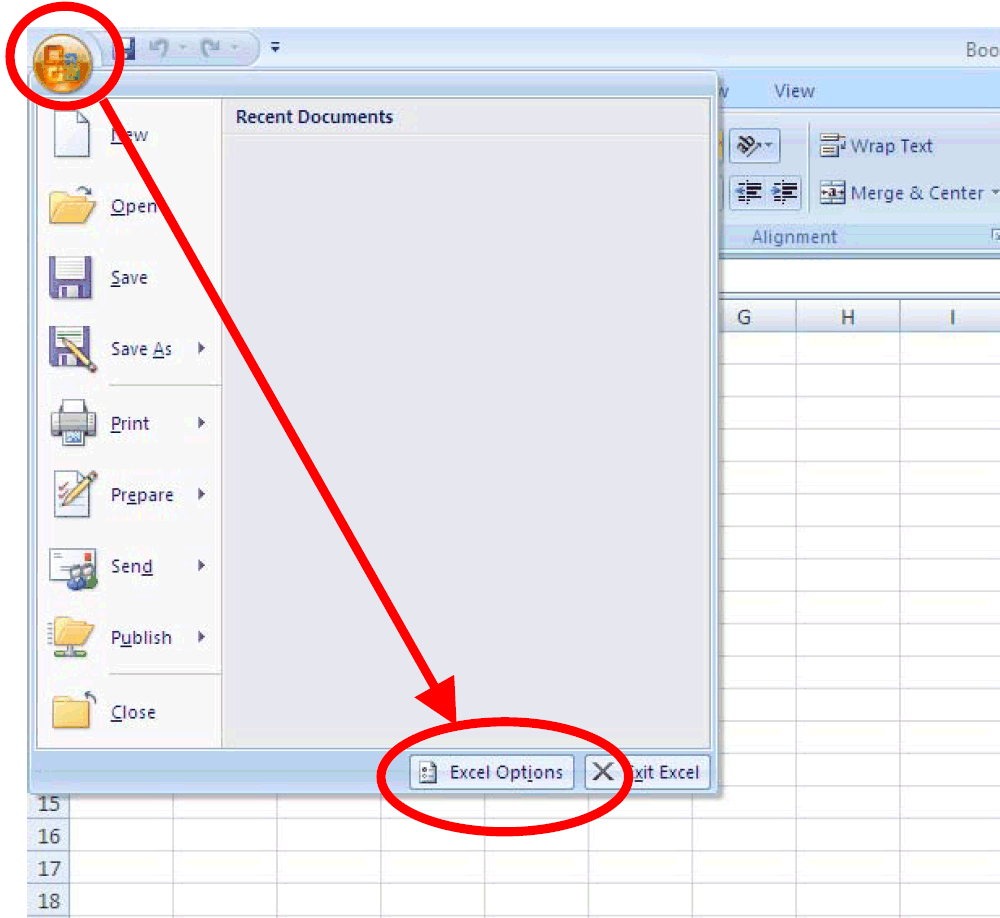
Fig. a. Go to "Parameters" dialog in Microsoft Excel
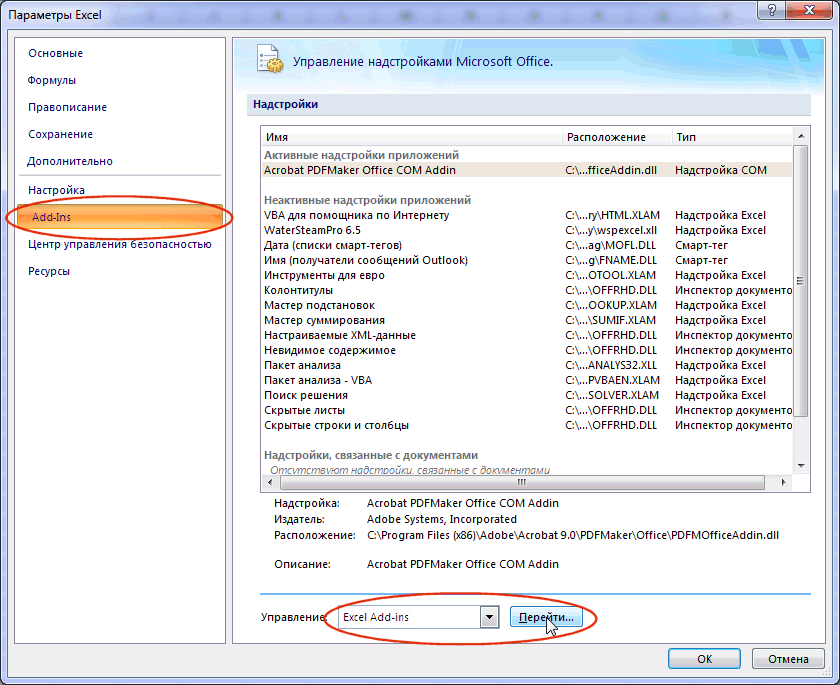
Fig. b. Go to "Add-ins" dialog in Microsoft Excel

Fig. c. "Add-ins" dialog in Microsoft Excel
 top top
Q9: How to add WSP functions in Visual Studio for .Net project (VB, C# etc)?
A: 1. Start Visual Studio (Express or full).
2. Create New or open existing project.
3. In Solution Explorer right click on project title. Choose “Add Reference...” item:
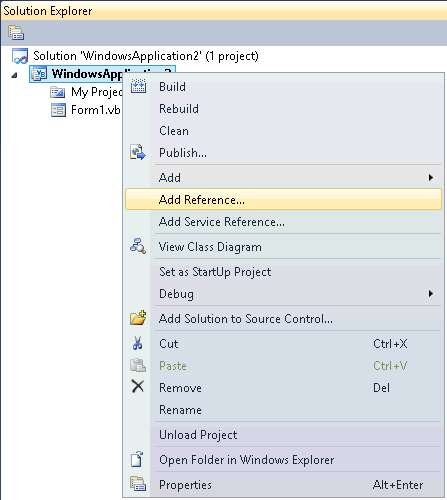
4. Choose “COM” tab:
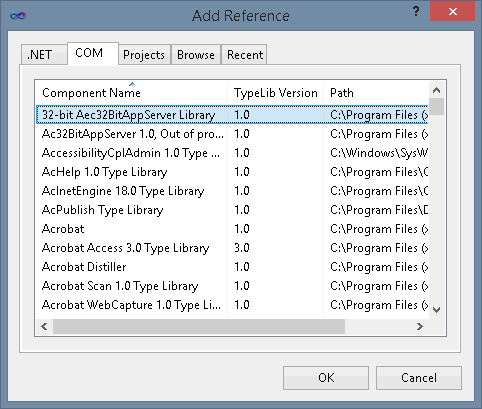
5. Search for the “WSP”:
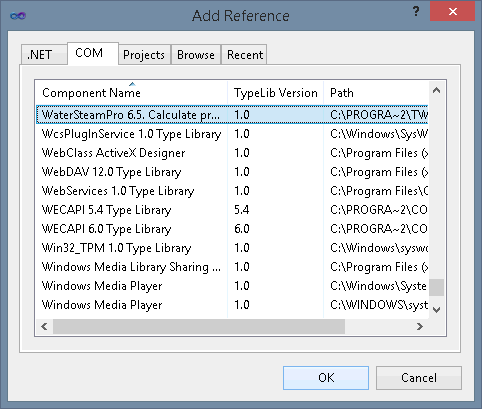
And press OK button.
6. Now you can reference to WSP functions in your code:
Visual Basic:
Dim wsp As OKAWSP6A.WSPCalculator, ps as Double
wsp = New OKAWSP6A.WSPCalculator
ps = wsp.wspPST(300 + 273.15) / 1E6 ' Calculate saturation pressure for 300 C and scale the result to MPa.
C#:
OKAWSP6A.WSPCalculator wsp = new OKAWSP6A.WSPCalculator();
double ps;
ps = wsp.wspPST(300 + 273.15) / 1E6; // Calculate saturation pressure for 300 C and scale the result to MPa.
Online documentation for WSP:
You can download above mentioned documentations in single (chm) files in download section.
CHM file ( ) is compiled (and compressed) html files. Usually it contains help information for programs for Microsoft Windows. ) is compiled (and compressed) html files. Usually it contains help information for programs for Microsoft Windows.
For questions, troubleshooting and wishes about WSP please contact Konstantin A. Orlov, E-mail: okawsp@hotmail.com
There is article about equations used for calculating the properties of gases and their mixtures. You can download article (pdf format) from: Thermal Engineering, Vol. 52, No. 3, 2005,
Note that article written for functions set used until WSP 6.0 beta 8. In final release functions set is changed. Additional information given in program documentation.
| 

